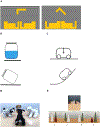A profile of spatial abilities in people with Down syndrome
- PMID: 38072820
- PMCID: PMC10872588
- DOI: 10.1111/jir.13111
A profile of spatial abilities in people with Down syndrome
Abstract
Background: Spatial abilities are fundamental cognitive abilities, have direct applications in daily life, serve as a cognitive foundation for many other complex skills and are used in many specialty jobs. The current study aimed to systematically and comprehensively evaluate the spatial abilities of individuals with Down syndrome (DS) relative to mental ability-matched typically developing (TD) children based on Newcombe and Shipley's double-dimension theoretical framework for classifying spatial abilities.
Methods: Forty adolescents and young adults with DS and 40 TD children completed a nonverbal intelligence test (Raven's), two measures of static-extrinsic skills (water-level task and cart task), two measures of static-intrinsic skills (figure ground and form completion), two measures of dynamic-extrinsic skills (three mountains task and dog task) and two measures of dynamic-intrinsic spatial skills (mental rotation task and block design task).
Results: Participants with DS showed reduced performance on two dynamic-intrinsic tasks and one static-extrinsic task (i.e. cart task) relative to TD children. Performances were similar in two dynamic-extrinsic tasks and two static-intrinsic tasks. Analyses of composite accuracy for each spatial category further confirmed deficits in dynamic-intrinsic and static-extrinsic categories for people with DS relative to TD children.
Conclusions: Our results showed an uneven profile of spatial abilities in people with DS relative to ability-matched TD children with particular weaknesses in comprehending and manipulating dynamic-intrinsic and static-extrinsic spatial relations. Furthermore, our research has important clinical implications for more targeted interventions to improve spatial abilities in people with DS.
Keywords: Down syndrome; dynamic vs. static; experimental; extrinsic vs. intrinsic; spatial abilities.
© 2023 John Wiley & Sons and MENCAP.
Conflict of interest statement
There are no competing interests for the authors in this study.
Figures



References
-
- Bergman Nutley S, Söderqvist S, Bryde S, Thorell LB, Humphreys K, & Klingberg T (2011). Gains in fluid intelligence after training non‐verbal reasoning in 4‐year‐old children: A controlled, randomized study. Developmental science, 14(3), 591–601. - PubMed
-
- Bihrle AM (1990). Visuospatial processing in Williams syndrome and Down syndrome. (Publication No. 303855976) [Doctoral dissertation, University of California, San Diego and San Diego State University]. ProQuest Dissertations Publishing.
-
- Carroll JB (1993). Human cognitive abilities: A survey of factor-analytic studies (1st ed.). Cambridge University Press. 10.1017/CBO9780511571312 - DOI
Publication types
MeSH terms
Grants and funding
LinkOut - more resources
Full Text Sources
Medical

